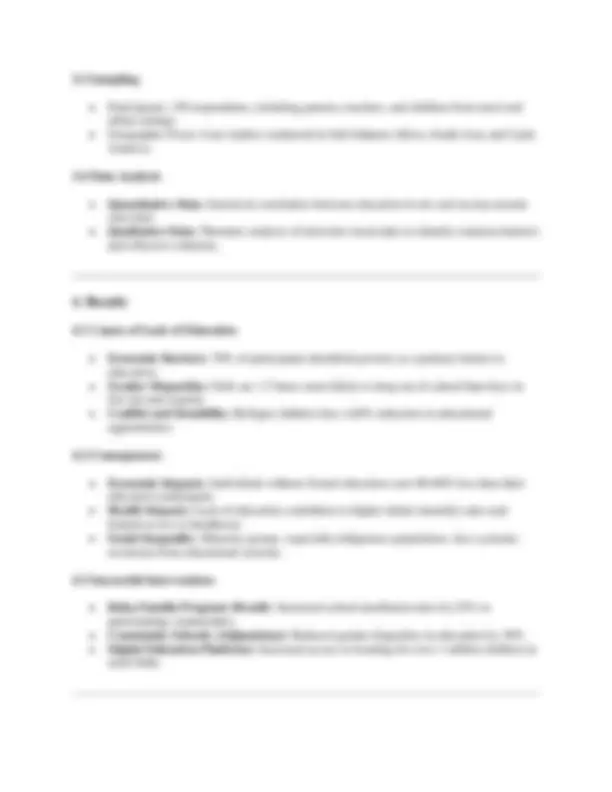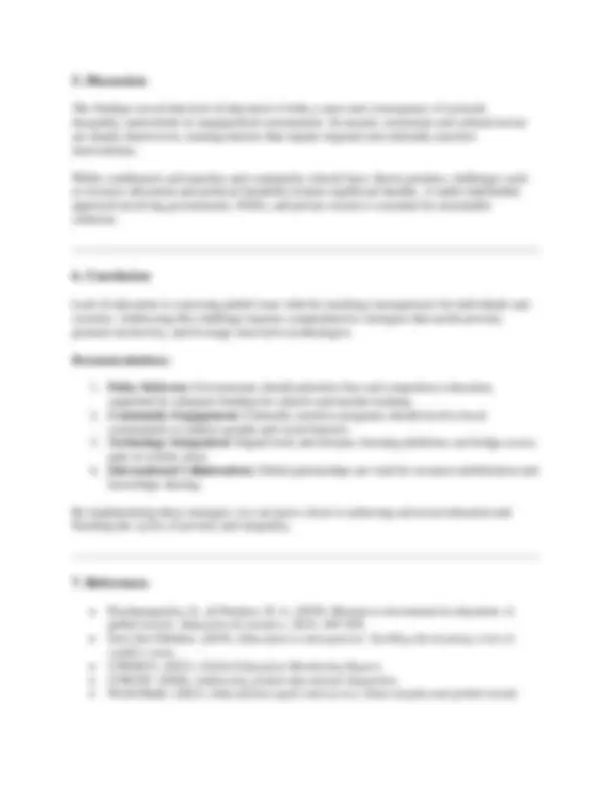




Study with the several resources on Docsity

Earn points by helping other students or get them with a premium plan


Prepare for your exams
Study with the several resources on Docsity

Earn points to download
Earn points by helping other students or get them with a premium plan
Community
Ask the community for help and clear up your study doubts
Discover the best universities in your country according to Docsity users
Free resources
Download our free guides on studying techniques, anxiety management strategies, and thesis advice from Docsity tutors
A World of Opportunity Starts with Education! Lack of Education: A Global Crisis We Can Solve Education is the key to breaking the cycle of poverty and inequality. However, millions of children and adults worldwide are still deprived of this basic human right. Our research delves into the causes, consequences, and solutions for the lack of education, a critical issue impacting not only individuals but entire societies. Key Findings: ✔️Poverty & Gender Inequality: These barriers keep children from accessing education. ✔️Global Impact: Lack of education fuels cycles of poverty, unemployment, and social instability. ✔️Success Stories: Programs like conditional cash transfers and community-based schools are making a difference. Take Action Be part of the solution! Empower communities, support inclusive education, and help pave the way for a better future! DOWNLOAD THE FULL REPORT NOW!!
Typology: Study Guides, Projects, Research
1 / 4

This page cannot be seen from the preview
Don't miss anything!



Education is a fundamental human right and a catalyst for sustainable development. Despite global efforts, over 244 million children and youth remain out of school, with marginalized populations disproportionately affected. This research examines the causes of lack of education, its impacts on individuals and societies, and effective solutions. Through a combination of quantitative analysis and case studies, the study identifies poverty, gender inequality, and conflict as primary barriers. The consequences include intergenerational poverty, unemployment, and social instability. Recommendations focus on inclusive policies, infrastructure development, and innovative programs to bridge educational gaps.
Education serves as the foundation for economic growth, social equity, and individual empowerment. Yet, millions of individuals worldwide are denied access to education, creating a pervasive global challenge. The lack of education contributes to systemic cycles of poverty and inequality, disproportionately affecting vulnerable groups such as women, rural populations, and conflict-affected communities. This research investigates the root causes and impacts of educational deprivation and highlights potential interventions to address this critical issue. Research Objectives:
2.1 Causes of Lack of Education Poverty: Families in low-income regions prioritize basic needs over education, with children often working to support household income (UNICEF, 2020). Gender Inequality: Cultural norms in many societies limit girls' access to education, especially in rural areas (UNESCO, 2021). Conflict and Displacement: Armed conflicts displace millions, leaving children without stable access to schools (Save the Children, 2019). Infrastructure Deficiencies: Rural areas lack adequate schools, qualified teachers, and learning materials (World Bank, 2021). 2.2 Consequences of Educational Deprivation Economic Impacts: Uneducated individuals face limited job opportunities, perpetuating cycles of poverty (Psacharopoulos & Patrinos, 2018). Health Outcomes: Lack of education correlates with poor health literacy, resulting in higher rates of preventable diseases. Social Inequality: Educational deprivation exacerbates disparities, particularly for women and marginalized groups (UNESCO, 2020). 2.3 Interventions and Success Stories Successful initiatives include: Conditional Cash Transfers: Programs like Bolsa Família in Brazil incentivize school attendance (World Bank, 2019). Community-Based Schools: Locally run schools in Afghanistan provide education in culturally sensitive ways (Save the Children, 2021). Technology in Education: Digital tools like mobile learning apps have expanded access in remote areas (UNICEF, 2022).
3.1 Research Design This study employs a mixed-methods approach, combining quantitative data analysis and qualitative case studies to provide a comprehensive understanding of the issue. 3.2 Data Sources Quantitative Data: Global education statistics from UNESCO, UNICEF, and the World Bank. Qualitative Data: Interviews with educators, policymakers, and families in underserved communities across Africa and South Asia.
The findings reveal that lack of education is both a cause and consequence of systemic inequality, particularly in marginalized communities. Economic constraints and cultural norms are deeply interwoven, creating barriers that require targeted and culturally sensitive interventions. While conditional cash transfers and community schools have shown promise, challenges such as resource allocation and political instability remain significant hurdles. A multi-stakeholder approach involving governments, NGOs, and private sectors is essential for sustainable solutions.
Lack of education is a pressing global issue with far-reaching consequences for individuals and societies. Addressing this challenge requires comprehensive strategies that tackle poverty, promote inclusivity, and leverage innovative technologies. Recommendations:
Psacharopoulos, G., & Patrinos, H. A. (2018). Returns to investment in education: A global review. Education Economics, 26 (5), 445-458. Save the Children. (2019). Education in emergencies: Tackling the learning crisis in conflict zones. UNESCO. (2021). Global Education Monitoring Report. UNICEF. (2020). Addressing global educational disparities. World Bank. (2021). Educational equity and access: Data insights and global trends.